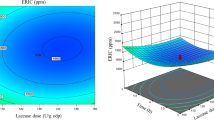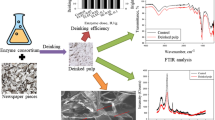Abstract
Application of microbial enzymes for paper deinking is getting tremendous attention due to the rapidly increasing of waste paper every year. This study reports the deinking efficiency of laser-printed paper by the lignocellulolytic enzyme from Penicillium rolfsii c3-2(1) IBRL strain compared to other enzyme sources as well as commercial available enzymes. High enzymatic deinking efficiency of approximately 82 % on laser-printed paper was obtained by pulp treatment with crude enzyme from P. rolfsii c3-2(1) IBRL. However, this crude enzyme was found to reduce the paper strength properties of the pulp based on the results of tensile, tear and burst indices, most probably due to the cellulose degradation. This was further proven by the low viscosity of paper pulp obtained after enzymatic treatment and increasing of sugar production during the treatment. Balancing to this detrimental effect on paper pulp, high deinking efficiency was achieved within a short period of time, in which the enzymatic treatment was conducted for 30 min that enabled contribution to higher brightness index obtained, thus promoting savings of time and energy consumption, therefore environmental sustainability. Extensive research should be conducted to understand the nature and mechanism of enzymatic deinking process by the crude enzyme from P. rolfsii c3-2(1) IBRL in order to improve paper strength properties.





Similar content being viewed by others
References
Bajpai, P. (1999). Application of enzymes in the pulp and paper industry. Biotechnology Progress, 15, 147–157.
Bajpai, P., & Bajpai, P. K. (1998). Deinking with enzymes: a review. Tappi Journal, 81, 111–117.
Borchardt, J. K., Miller, J. D., & Azevedo, M. A. D. (1998). Office paper de-inking. Current Opinion in Colloid & Interface Science, 3, 360–367.
Cao, B., Tschirner, U., & Ramaswamy, S. (1998). Impact of pulp chemical composition on recycling. Tappi Journal, 81, 119–127.
Chander Kuhad, R., Mehta, G., Gupta, R., & Sharma, K. K. (2010). Fed batch enzymatic saccharification of newspaper cellulosics improves the sugar content in the hydrolysates and eventually the ethanol fermentation by Saccharomyces cerevisiae. Biomass and Bioenergy, 34, 1189–1194.
Das, A., Paul, T., Halder, S. K., Jana, A., Maity, C., Das Mohapatra, P. K., Pati, B. R., & Mondal, K. C. (2013). Production of cellulolytic enzymes by Aspergillus fumigatus ABK9 in wheat bran-rice straw mixed substrate and use of cocktail enzymes for deinking of waste office paper pulp. Bioresource Technology, 128, 290–296.
Feria, M. J., García, J. C., Díaz, M. J., Garrote, G., & López, F. (2012). Optimization the soda-AQ process for cellulose pulp production and energy content of black liquor from L. leucocephala K360. Bioresource Technology, 120, 173–179.
Genco, J. M., Busayasakul, N., Medhora, H. K., & Robbins, W. (1990). Hemicellulose retention during Kraft pulping. Tappi Journal, 73, 223–233.
Ghose, T. K. (1987). Measurement of cellulase activities. Pure and Applied Chemistry, 59, 257–268.
Goyal, A., Ghosh, B., & Eveleigh, D. (1991). Characteristics of fungal cellulases. Bioresource Technology, 36, 37–50.
Gubitz, G. M., Mansfield, S. D., & Saddler, J. N. (1998). Effectiveness of two endoglucanases from Gloeophyllum sp. in deinking mixed office waste paper. In Proceedings of the International Conference on Biotechnology in the Pulp and Paper Industry (pp. C135–C138).
Ibrahim, R. (2003). Structural, mechanical and optical properties of recycled paper blended with empty oil palm fruit bunch pulp. Journal Oil Palm Research, 15, 28–34.
Kanda, T., Wakabayashi, K., & Nisizawa, K. (1980). Purification and properties of a lower-molecular-weight endo-cellulase from Irpex lacteus (Polyporus tulipiferae). Journal of Biochemistry, 87, 1625–1634.
Lee, C. K., Darah, I., & Ibrahim, C. O. (2007). Enzymatic deinking of laser printed office waste papers: some governing parameters on deinking efficiency. Bioresource Technology, 98, 1684–1689.
Lee, C. K., Ibrahim, D., & Che Omar, I. (2013). Enzymatic deinking of various types of waste paper: efficiency and characteristics. Process Biochemistry, 48, 299–305.
Lee, C. K., Ibrahim, D., Ibrahim, C. O., & Rosli, W. D. W. (2011). Enzymatic and chemical deinking of mixed office wastepaper and old newspaper: paper quality and effluent characteristics. BioResources, 6, 3859–3875.
Lee, K. C., Arai, T., Ibrahim, D., Deng, L., Murata, Y., Mori, Y., & Kosugi, A. (2016). Characterization of oil-palm trunk residue degradation enzymes derived from the isolated fungus, Penicillium rolfsii c3-2(1) IBRL. Environmental Technology, 37, 1550–1558.
Linder, M., & Teeri, T. T. (1997). The roles and function of cellulose-binding domains. Journal of Biotechnology, 57, 15–28.
Liu, J., & Hu, H. (2012). The role of cellulose binding domains in the adsorption of cellulases onto fibers and its effect on the enzymatic beating of bleached Kraft pulp. BioResources, 7, 878–892.
Marques, S., Pala, H., Alves, L., Amaral-Collaço, M. T., Gama, F. M., & Gírio, F. M. (2003). Characterisation and application of glycanases secreted by Aspergillus terreus CCMI 498 and Trichoderma viride CCMI 84 for enzymatic deinking of mixed office wastepaper. Journal of Biotechnology, 100, 209–219.
Mazumder, B., Ohtani, Y., Cheng, Z., & Sameshima, K. (2000). Combination treatment of kenaf bast fiber for high viscosity pulp. Journal of Wood Science, 46, 364–370.
Miller, G. L. (1959). Use of dinitrosalicylic acid reagent for determination of reducing sugar. Analytical Chemistry, 31, 426–428.
Mohandass, C., & Raghukumar, C. (2005). Biological deinking of inkjet-printed paper using Vibrio alginolyticus and its enzymes. Journal of Industrial Microbiology & Biotechnology, 32, 424–429.
Pala, H., Lemos, M. A., Mota, M., & Gama, F. M. (2001). Enzymatic upgrade of old paperboard containers. Enzyme and Microbial Technology, 29, 274–279.
Pala, H., Mota, M., & Gama, F. M. (2004). Enzymatic versus chemical deinking of non-impact ink printed paper. Journal of Biotechnology, 108, 79–89.
Pala, H., Mota, M., & Gama, F. M. (2006). Factors influencing MOW deinking: laboratory scale studies. Enzyme and Microbial Technology, 38, 81–87.
Pang, P. K. (2010) Production of cellulase and xylanase by indigenous Aspergillus niger AI-1 via solid substrate fermentation and its application in deinking of mixed office waste paper. Malaysia: Universiti Sains Malaysia, Ph.D. thesis (pp. 261–318)
Pathak, P., Bhardwaj, N. K., & Singh, A. K. (2011). Optimization of chemical and enzymatic deinking of photocopier waste paper. BioResources, 6, 447–463.
Pèlach, M. A., Pastor, F. J., Puig, J., Vilaseca, F., & Mutjé, P. (2003). Enzymic deinking of old newspapers with cellulase. Process Biochemistry, 38, 1063–1067.
Qian, Y., & Goodell, B. (2005). Deinking of laser printed copy paper with a mediated free radical system. Bioresource Technology, 96, 913–920.
Qin, M., Gao, P., Shao, Z., Fu, Y., & Wang, Q. (2000). Enzymatic deinking of old newsprint. China Pulp & Paper, 19, 7–13.
Quick, T. H., & Hodgson, K. T. (1986). Xerography deinking—a fundamental approach. Tappi Journal, 69, 102–106.
Sadana, J. C., Lachke, A. H., & Patil, R. V. (1984). Endo-(1 → 4)-β-d-glucanases from Sclerotium rolfsii. Purification, substrate specificity, and mode of action. Carbohydrate Research, 133, 297–312.
Soni, R., Nazir, A., & Chadha, B. S. (2010). Optimization of cellulase production by a versatile Aspergillus fumigatus fresenius strain (AMA) capable of efficient deinking and enzymatic hydrolysis of Solka floc and bagasse. Industrial Crops and Products, 31, 277–283.
Soni, R., Nazir, A., Chadha, B. S., & Saini, H. S. (2008). Novel sources of fungal cellulases for efficient deinking of composite paper waste. BioResources, 3, 234–246.
Terrasan, C. R. F., Temer, B., Duarte, M. C. T., & Carmona, E. C. (2010). Production of xylanolytic enzymes by Penicillium janczewskii. Bioresource Technology, 101, 4139–4143.
van Wyk, J. P. H. (2001). Sequential bioconversion of used paper to sugars by cellulases from Trichoderma reesei and Penicillium funiculosum. Environmentalist, 21, 211–220.
Verma, N., Bansal, M. C., & Kumar, V. (2011). Enzymatic deinking with cellulases: a review. Journal Solid Waste Technology Management, 37, 297–306.
Viesturs, U., Leite, M., Eisimonte, M., Eremeeva, T., & Treimanis, A. (1999). Biological deinking technology for the recycling of office waste papers. Bioresource Technology, 67, 255–265.
Virk, A. P., Puri, M., Gupta, V., Capalash, N., & Sharma, P. (2013). Combined enzymatic and physical deinking methodology for efficient eco-friendly recycling of old newsprint. PloS One, 8, e72346.
Vyas, S., & Lachke, A. (2003). Biodeinking of mixed office waste paper by alkaline active cellulases from alkalotolerant Fusarium sp. Enzyme and Microbial Technology, 32, 236–245.
Zhang, X., Renaud, S., & Paice, M. (2008). Cellulase deinking of fresh and aged recycled newsprint/magazines (ONP/OMG). Enzyme and Microbial Technology, 43, 103–108.
Zhenying, S., Shijin, D., Xuejun, C., Yan, G., Junfeng, L., Hongyan, W., & Zhang, S. X. (2009). Combined de-inking technology applied on laser printed paper. Chemical Engineering and Processing: Process Intensification, 48, 587–591.
Acknowledgments
The first author would like to thank the Ministry of Higher Education in Malaysia for financial support. The research grant scheme USM-PRGS also supported this project. The author is also grateful for the useful advices and guidance from Dr. Leh Cheu Peng, Miss Tye Ying Ying, and Miss Chong Yin Hui as well as facilities provided by School of Industrial Technology, Universiti Sains Malaysia.
Author information
Authors and Affiliations
Corresponding author
Rights and permissions
About this article
Cite this article
Lee, K.C., Tong, W.Y., Ibrahim, D. et al. Evaluation of Enzymatic Deinking of Non-impact Ink Laser-Printed Paper Using Crude Enzyme from Penicillium rolfsii c3-2(1) IBRL. Appl Biochem Biotechnol 181, 451–463 (2017). https://doi.org/10.1007/s12010-016-2223-4
Received:
Accepted:
Published:
Issue Date:
DOI: https://doi.org/10.1007/s12010-016-2223-4




